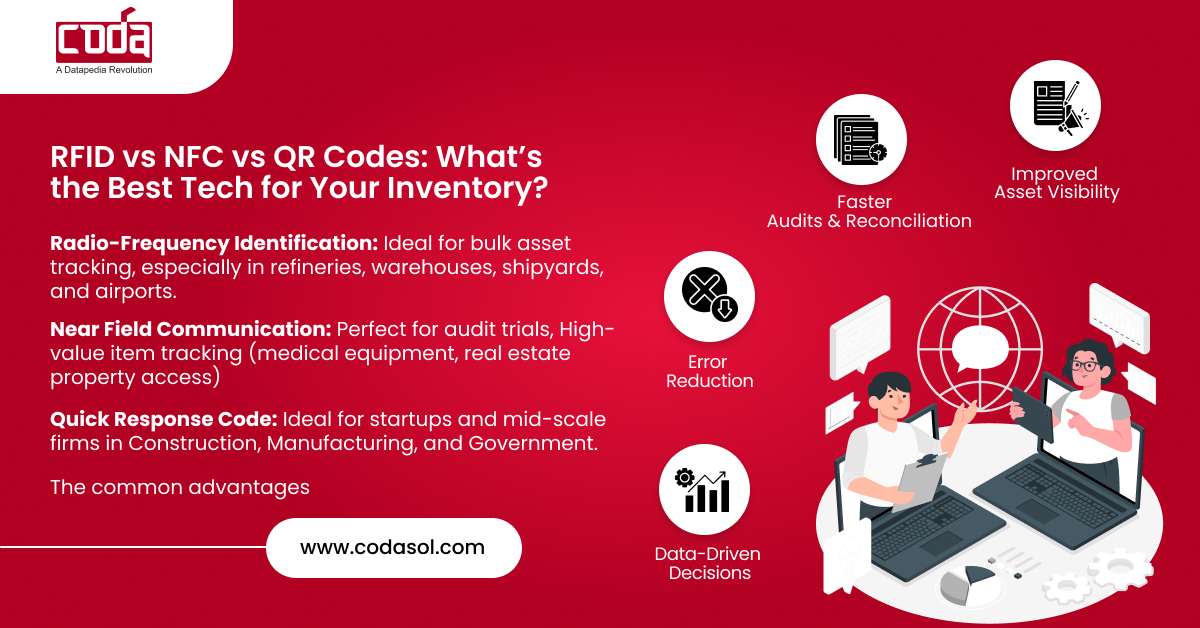If you’re in Oil & Gas, Manufacturing, or even Healthcare, you’ve likely battled one or more of these problems:
- Missing assets or MRO spares
- Manual entry errors
- Incomplete tracking history
- Stockouts and ghost inventory
Here’s the short answer:
RFID is best for bulk asset tracking, NFC works great for secure, close-range scanning, and QR codes are the most cost-effective choice.
But which one fits your operations best?
Let’s compare RFID vs NFC vs QR Code inventory tracking to help you make a smart, scalable decision fast.
RFID vs NFC vs QR Codes: What are they, really?
| Technology | Stands For | Range | Cost | Use Case |
|---|---|---|---|---|
| RFID | Radio-Frequency Identification | Up to 10m (active) | High | Warehouses, refineries |
| NFC | Near Field Communication | < 10 cm | Medium | Secure item-level tracking |
| QR Code | Quick Response Code | Visual line-of-sight | Low | Entry-level, low-budget tracking |
RFID:
RFID labels for inventory shine in high-speed environments.
“We reduced our cycle counting time by 75% after switching to RFID.”
— Logistics Manager, Gulf Oil Terminal (UAE)
Pros:
- Scans multiple items simultaneously
- Doesn’t require line-of-sight
- Durable in harsh environments (ideal for Oil & Gas, Ports, EPC sectors)
Cons:
- Higher implementation cost
- Interference in metal-heavy environments
- Needs readers and tags setup
Best for:
- Bulk inventory in refineries, warehouses, shipyards, and airports
- Long-range, real-time asset visibility
- Industries with large-scale operations like Defense, Aviation, Utilities, EPC
NFC:
NFC inventory solutions are rising in popularity in Healthcare, Real Estate, and Retail Banking.
Pros:
- Tap-to-read simplicity
- More secure than QR
- Works with smartphones
Cons:
- Very short range
- Slower than RFID for bulk
- Requires special tags or chips
Best for:
- High-value item tracking (medical equipment, real estate property access)
- Controlled access zones (Defence, Government, Healthcare)
- Secure audit trails (e.g., medication administration or asset handovers)
QR Codes:
QR code asset labels are ideal when you need speed and savings.
“With just a printer and smartphone, we rolled out QR tracking to 12 construction sites in under a week.”
— Inventory Head, Real Estate Major, India
Pros:
- Inexpensive
- No special hardware required
- Easy to deploy and update
Cons:
- Must be scanned manually
- Can be damaged or duplicated
- Needs line-of-sight
Best for:
- Startups and mid-scale firms in Construction, Manufacturing, and Government
- Tracking less-critical assets or temporary equipment
- Use in India, Far East, and emerging GCC economies
Use Case: Offshore Oil Rig (GCC)
Challenge:
An EPC contractor in Oman struggled with misplaced spares during rig turnaround.
Solution:
- Tagged spares using RFID for bulk storage zones
- Tagged tools with NFC for secure, person-level checkouts
- Tagged consumables with QR codes to track usage and reorders
Result:
- 93% faster retrieval
- 40% less over-ordering
- ROI achieved in 6 months
Which One Should You Choose?
Here’s a decision matrix based on your priority:
| Priority | Recommended Tech |
|---|---|
| Low-cost, fast rollout | QR Code |
| Secure, person-level interaction | NFC |
| Bulk scanning, rugged conditions | RFID |
| Mixed use across zones | Hybrid (RFID + NFC + QR) |
Cost vs ROI Table
| Tech | Maintenance | Typical ROI Time | Example Use |
|---|---|---|---|
| RFID | Medium | 6–12 months | MRO warehouse |
| NFC | Low | 3–6 months | Secure hospital equipment |
| QR Code | Very Low | Immediate to 3 months | Construction site tagging |

Still not sure which one suits your operations?
Speak with an MRO digitization expert in your region.
Expert Insight
“Choosing the right tagging tech isn’t about trends—it’s about ROI. A QR code might cost ₹2 while an RFID setup might cost ₹2,000 per item. But if downtime costs you ₹20 lakh an hour, the decision becomes obvious.”
— Anil Mehta, CTO – Smart Asset Systems, CODASOL
CODASOL’s next-gen inventory visibility platform
i-Stock seamlessly integrates RFID, NFC, and QR code technologies into a single, unified system. Designed for complex environments like Oil & Gas, EPC, Utilities, and Manufacturing, i-Stock enables real-time tracking, automated reconciliation, and actionable analytics, whether you’re managing MRO spares, capital assets, or consumables.
Its intuitive interface and ERP-ready architecture (SAP, Maximo, Oracle) ensure fast deployment and minimal disruption, delivering up to 80% reduction in inventory cycle times. With i-Stock, businesses across India, GCC, and the Far East can eliminate stock discrepancies, reduce pilferage, and unlock a data-driven supply chain advantage.
Implementation Best Practices
RFID
- Use on-metal tags for steel equipment
- Map out reader zones carefully
- Integrate with ERP/CMMS systems like SAP or Maximo
NFC
- Use tamper-evident tags for critical tools or devices
- Train field staff on tap-and-log SOPs
- Consider dual authentication (scan + PIN) for secure environments
QR Code
- Protect printed labels with laminates
- Use dynamic QR codes if tracking needs evolve
- Store minimal data in the code; link to cloud for security
Conclusion
You don’t need the most expensive solution. You need the right one.
Whether you’re operating a power plant in India, a naval base in Oman, or a real estate portfolio in Singapore, choosing between RFID, NFC, and QR codes starts with your inventory size, criticality, budget, and industry compliance.
Still unsure? Combine them.
Hybrid inventory systems can give you flexibility while staying cost-effective.
Frequently Asked Questions
1: Which is the cheapest inventory tagging method?
QR codes are the most cost-effective. You can print them for pennies and scan them with any smartphone.
2: Can RFID and NFC be used together?
Yes. Many companies use RFID for warehouses and NFC for tool checkouts or access logs.
3: Are QR codes secure for sensitive inventory?
Not inherently. While cost-effective, QR codes can be copied or damaged easily. NFC or RFID is better for high-value items.
4: What tech works best in the marine sector?
RFID, especially rugged UHF tags, perform well around containers, shipyards, and dock inventory due to moisture resistance.
5: What if our operations span multiple countries?
A hybrid approach works best—RFID in bulk facilities (e.g., UAE, India), QR for low-cost zones (e.g., Vietnam), and NFC where security is key (e.g., Airports or Healthcare).
Book a free demo of i-Stock and see how real-time tracking can reduce your inventory costs by up to 30%.


